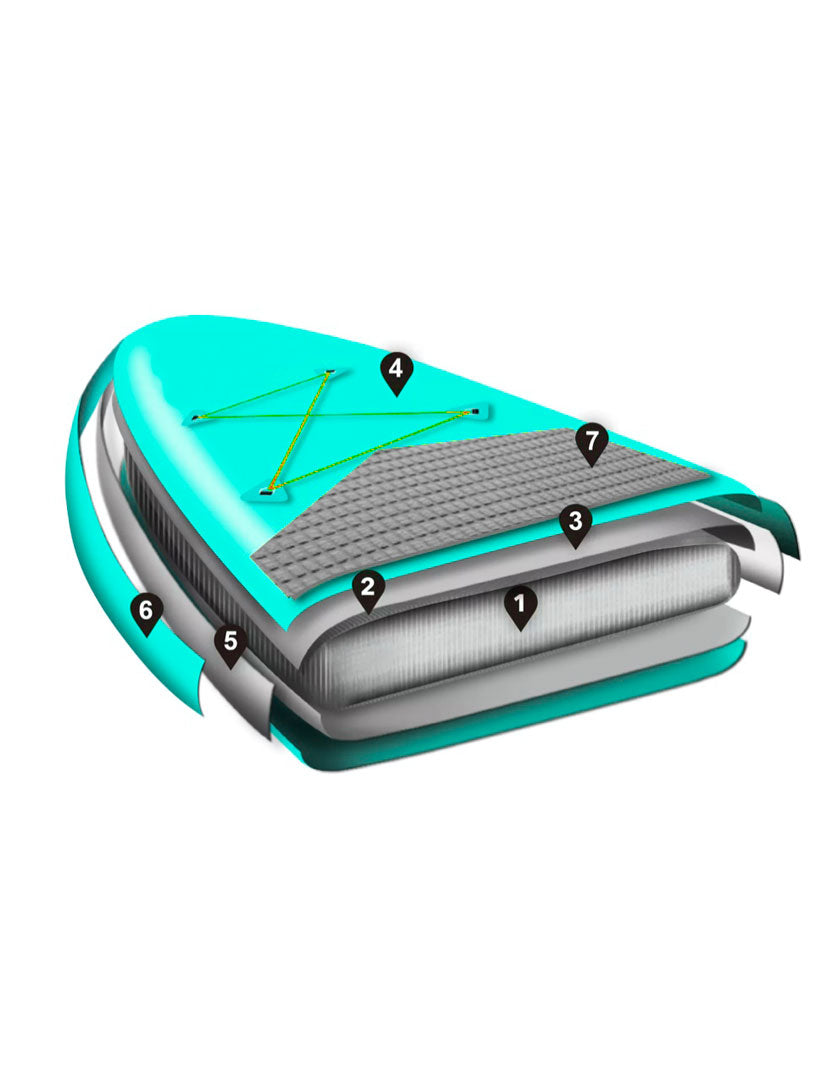SUP construction
There are various methods of constructing an inflatable SUP. The various methods often reflect quality and durability. Here we take a small review of the most common of the boards that are on sale:
SINGLE LAYER TECHNOLOGY
All construction methods start with dropstitch; thousands of internal threads between the two dropstitch layers which when filled with air only allow the board to expand to a certain point before contracting to form the rigid SUP shape. Dropstitch fabric itself is not airtight, so a liquid PVC layer covers the dropstitch which, when dry, creates an airtight seal. This is "single layer".
The two main advantages of single-layer boards are weight and price. Less material makes for a very light SUP and cheaper production. This construction has a slightly lower maximum weight than "Stringer" and laminated versions.
The advantage of single layer is that it is often sold very reasonably. The downside is that they are not as durable as boards with a double layer and will also not give you such an authentic paddling experience due to the thickness which gives more flex in the board.

STRINGER CONSTRUCTION
This type of SUP is mainly made in the same way as "Single layer" SUP. The difference is the addition of "stringer". This concept comes from traditional surfboard manufacturing, where a thin "stringer" runs down the center of the board from nose to tail to provide increased stiffness. On these inflatable SUP boards, the stringer is a fairly wide PVC strip glued down the middle of the board.
The point of using "stringer" is to increase the stiffness of the SUP and reduce the flexibility when you stand on the board and paddle. The extra piece of material creates a more solid platform, which in turn provides a better paddling experience. Since there is only a small addition of material, this does not add much to the weight and the cost of these boards remains low.
While the stringer is a nice addition, it won't change the world. It still won't be as rigid a board as the double layer construction.
FUSION DOUBLE LAYER CONSTRUCTION
The laminated double layer construction, "Double layer", is first class standard technology in inflatable SUP production.
The lamination process means that there are no longer cosmetic wrinkles or bubbles on the plate's surface. And here's where it's really impressive... these inflatable SUPs are 20-25% lighter and 25-30% stiffer than those that use a bonded double layer construction. That can mean a weight saving of around 2 kg, which is a lot on a SUP! These SUPs are often somewhat more expensive than the other constructions, but if you are looking for the best performance, it is the laminated double layer that applies.
Saltråk SUP is made with this method.

WOVEN FUSION DOUBLE LAYER CONSTRUCTION
The woven Fusion double layer construction is the first technology in the inflatable SUP manufacturing process introduced a few years ago.
The woven process makes the board even lighter and stiffer, and this is admittedly stiff and light compared to the already stiff and light material of "fusion double laminated". This new material really comes into its own for paddlers who port a lot on the river and canal settings or paddlers who struggle to carry heavy. This can be both short, light paddlers or a paddler with back problems.

GLUED DOUBLE LAYER CONSTRUCTION
Glued double-layer construction is now only reserved for boards that need to be super strong (for use in e.g. rivers) or cheaper brands that use outdated technology. A glued double-layer construction starts with the single-layer board; dropstitch covered by a first PVC layer. From there, a second layer of PVC is glued to the board (not laminated). This differs from stringer technology as there is a full coating over the entire board, not just a strip down the middle. It is also common to have an extra layer around the edge of the board.
The extra PVC layer helps to increase the board's strength, but it also makes it heavier.

